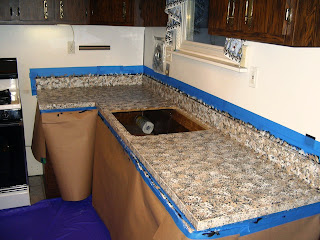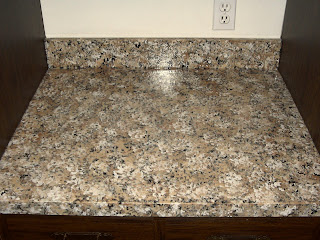For several months my wife and I discussed how we could give a makeover to our old laminate kitchen countertop. We don’t have a big countertop. The sink countertop is L-shaped, 8 feet in length, with the L part extending about 18 inches from the 2 foot wide main section. We also have a 2 foot by 2 foot desk section that matches the sink countertop. All told, we have 11.5 feet of standard 2 foot wide countertop.
We investigated our makeover options in the typical fashion. After being shocked by the megaprice of granite, and even the $600 cost of replacing the existing countertop with another laminate top, we investigated tiling the countertop. I even bought a tile saw. Before buying the tile, we ran across some information on countertop paint kits, and visited the Giani Granite website http://gianigranite.com/indexcountertoppaint.html to learn more. Encouraged by the testimonials both on the Giani site and elsewhere on the web, we decided to try the kit. It appears that in the last few years Giani’s marketing strategy has been to give away kits to bloggers in return for writing up their experiences. We are not one of those bloggers. We bought the Giani Sicilian Sand kit on Amazon.com for $69.95 including shipping. Here is a “before” picture of our countertop:
 |
| Our countertop was in great shape structurally, but had many superficial scratches and stains. The color also did not go with the laminate floor we put in a couple years ago. |
 |
| There is a matching desk section that we use for the microwave oven. |
After watching the instructional DVD and armed with the detailed Giani paint kit instructions, we started the project on Saturday morning, February 18. We were aiming to replace the sink with our countertop makeover, so I shut the power off to the disposal and spent a couple hours disconnecting the disposal, water lines, dishwasher and sink drain lines, and pulling up the chipped old 50 pound porcelain over cast iron sink. I found that the countertop cutout for the sink was too small for the Elkay Lustertone stainless sink we were planning to put in, so I had to spend some time enlarging the sink cutout. It was not easy because my jigsaw wouldn’t reach the back edge of the cutout due to the presence of the backsplash. After some effort I finally enlarged the sink cutout.
On Saturday afternoon my wife Jeanne and I scrubbed the countertop using SOS pads, and cut away the silicone caulking that had been used at the joint between the countertop and bottom edge of the backsplash, and where the backsplash and counter met the walls. While the silicone caulk cut away easily, it left a layer on every surface where it was cut away. We used razor scrapers, and even sandpaper, but we could not remove the silicone caulk residue from the Formica surfaces. Removal of all the residue is important because paint will not stick to the residue. Following the instructions in the Giani instructional DVD that came with the kit, we wiped the silicone caulk residue with isopropyl alcohol as instructed, but it did not remove the silicone residue. From reading on the web, wiping the silicone caulk with denatured alcohol only works if the caulk has not set up.
Monday, February 20. We practiced applying the three color coats with the pieces of sea sponge using the black paper supplied in the kit. After getting the hang of it, we started applying the color coats. In the Sicilian Sand Kit, the three colors that go on after the primer are feldspar brown, Inca gold, and then finally limestone white. There were several lessons learned in this part of the job. First, we learned to work in small two foot sections so the wet paint layers blend into each other. Another key pointer is to use the paint sparingly on vertical back splash surfaces and countertop edges because it will run. We had trouble getting into the corners with the sponges, so we used the recommended half inch brush a lot in the corners to apply the three layers of paints. When we finished applying the paint layers to the countertops we weren’t quite happy with the way it looked, so we decided to let it dry and work on it again on Tuesday.
Tuesday, February, 21. We noticed several areas where the patterns didn’t look random enough. Using all four colors to “fix up” the areas we were concerned about, we finally arrived at good enough. A key was reapplying black splotches in the areas where we had put too many colors. We let our color paint layer dry overnight and here's what we got:
 |
| The primer and color coats have been painted on, awaiting the polyurethane top coats. |
 |
| For us, painting inside corners was difficult with the smallest sponge section. We did most of the corners with a half inch paintbrush, and used the sponge to give it some texture. |
 |
| Close-up of the color coats before applying the polyurethane. |
Wednesday, February 22. We lightly sanded the color coat with 600 grit sandpaper and wiped it with a damp cloth. After letting the damp surface dry for an hour, we rolled on the first polyurethane coat following the instructions. A key in this step is keeping the roller wet so that you don’t hear the SSSS sound of a dry roller rolling over the surface.
Friday, February 24. In the a.m. Jeanne lightly sanded the repair area, wiped it down, waited for it to dry and reapplied the polyurethane in that area to her satisfaction. On Friday night when Ken returned from work he caulked the interior seams with Alex 230 Crystal Clear acrylic caulk, and the areas where the backsplash meets the wall with Alex 230 brilliant white acrylic caulk.
Saturday, February 25. The new sink was set in place using Loctite Polyseamseal Ultra and the Elkay sink clips. The water lines, disposer, dishwasher and sink drain lines were reattached and the job was completed.
Our impression: This kit exceeded our expectations. The renewed countertops, new sink and new faucet transformed the look of our kitchen. We think the countertops look fabulous, and hope that they will provide many years of service. Here are the results:
 |
| The top polyurethane coats gave the countertop a highly glossy finish. |
 |
| Sink area. |
 |
| Desk area. |
 |
| Our "after" picture of the countertop. |
On a second occasion, my son put a hot coffee cup down on the countertop and left it in place overnight. In the morning, there small blisters in the shape of a ring where the cup bottom had been in contact with the top. We again wiped down the top with water in that area, and within an hour the blister ring disappeared and the top looked as if nothing had taken place.
Perhaps our top has not fully cured and hardened, but it has been interesting to see that both of these “injuries” were “healed” by wiping with a damp cloth.
February 21, 2013 Update: It has now been about a year since we did our countertop makeover. I have been very happy with how the countertop has held up in daily kitchen use during the first year. I think it took about 6 months to fully cure the polyurethane top coats. I say that because as mentioned in the update above, for about the first six months we had to be careful about leaving long-standing water on the top or you could feel the little bumps in the area where the water had been. We noticed that his happened especially when wet cups were left on the countertop overnight and the countertop surface was wet under the cup for a long time. When the counter surface dried out, the bumps always went away and there was no permanent damage, but we took care to make sure the top was wiped dry after we figured out what was going on.
After about six months, we noticed that long-standing water exposure to the countertop was no longer a problem, and I think it is because the polyurethane coat had fully cured. If the polyurethane is truly an automotive grade coating as Giani claims, it makes sense that it would take a while to fully cure at room temperature. In a car manufacturing facility, after the clear coatings are applied the cars are usually baked in a high temperature oven to quickly cure the polyurethane. At room temperature, I think the curing process takes a lot longer, and in our case about 6 months seemed to be the time it took to fully cure. Cosmetically, the countertop still looks wonderful, and still shines like new. I am very happy with the new life that the countertop paint gave to my old laminate kitchen countertop.
Final Update: The Giani countertop paint lasted about three years, and then the clearcoat began to degrade. It began to peel away in the highest use areas, and where hot things were placed on the countertop. Soon the undercoat began to peel away, revealing the blue formica beneath it. I suppose I could have been more diligent to reapply a clearcoat when it began to degrade, but I didn't do that. Painting the countertop was a good cosmetic fix until we were able to remodel our kitchen in 2017. We now have a granite top. Here's the new look.

